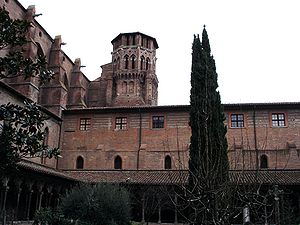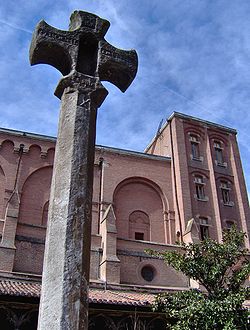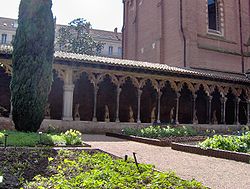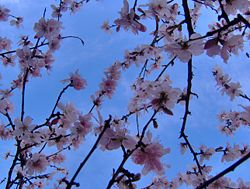
Musée des Augustins
Encyclopedia


Toulouse
Toulouse is a city in the Haute-Garonne department in southwestern FranceIt lies on the banks of the River Garonne, 590 km away from Paris and half-way between the Atlantic Ocean and the Mediterranean Sea...
, France
France
The French Republic , The French Republic , The French Republic , (commonly known as France , is a unitary semi-presidential republic in Western Europe with several overseas territories and islands located on other continents and in the Indian, Pacific, and Atlantic oceans. Metropolitan France...
which conserves a collection of sculpture and paintings from the Middle Ages
Middle Ages
The Middle Ages is a periodization of European history from the 5th century to the 15th century. The Middle Ages follows the fall of the Western Roman Empire in 476 and precedes the Early Modern Era. It is the middle period of a three-period division of Western history: Classic, Medieval and Modern...
to the early twentieth century. The paintings are from throughout France, the sculptures representing Occitan culture of the region with a particularly rich assemblage of Romanesque sculpture.
History


Gothic architecture
Gothic architecture is a style of architecture that flourished during the high and late medieval period. It evolved from Romanesque architecture and was succeeded by Renaissance architecture....
style and prior to the French Revolution
French Revolution
The French Revolution , sometimes distinguished as the 'Great French Revolution' , was a period of radical social and political upheaval in France and Europe. The absolute monarchy that had ruled France for centuries collapsed in three years...
housed Toulouse's Augustinian convent
Augustinian convent (Toulouse)
The Couvent des Augustins in Toulouse was a convent of Augustinian hermits founded in 1268. It was first set up outside the walls of the city, near porte Matabiau, then moved between 1310 and 1341 in the corner of rue du Musée and rue des Arts. It was suppressed in 1790 and its buildings used to...
. The convent was secularized in 1793 and first opened to the public as a museum on 27 August 1795 by decree of the French Convention, very shortly after the opening of the Louvre
Louvre
The Musée du Louvre – in English, the Louvre Museum or simply the Louvre – is one of the world's largest museums, the most visited art museum in the world and a historic monument. A central landmark of Paris, it is located on the Right Bank of the Seine in the 1st arrondissement...
, making it one of the oldest museums in France after the Louvre. It at first housed the Muséum Provisoire du Midi de la République and the école des Beaux-Arts.
The Musée des Augustins de Toulouse was one of fifteen museums founded in provincial centres, by a decree of 13 Fructidor
Fructidor
Fructidor is the twelfth month in the French Republican Calendar. The month was named after the Latin word fructus, which means "fruit".Fructidor is the third month of the summer quarter . By the Gregorian calendar, Fructidor starts on either August 18 or August 19 and ends exactly thirty days...
year IX (31 August 1801), which was promulgated by the minister of the interior, Jean-Antoine Chaptal
Jean-Antoine Chaptal
Jean-Antoine Claude, comte Chaptal de Chanteloup was a French chemist and statesman. He established chemical works for the manufacture of the mineral acids, soda and other substances...
. At the start of the 19th century several medieval buildings (notably the refectory) were demolished and in their place Viollet-le-Duc and his pupil Darcy
Darcy
A darcy and millidarcy are units of permeability, named after Henry Darcy. They are not SI units, but they are widely used in petroleum engineering and geology. Like other measures of permeability, a darcy has the same units as area.-Definition:Permeability measures the ability of fluids to...
put up new exhibition galleries, accessed by a Gothic Revival monumental stair offering an interplay of richly complicated vaulting
Vault (architecture)
A Vault is an architectural term for an arched form used to provide a space with a ceiling or roof. The parts of a vault exert lateral thrust that require a counter resistance. When vaults are built underground, the ground gives all the resistance required...
systems. The works continued from 1873 to 1901, when the museum reopened. In effect, Toulouse commissioned Urbain Vitry to ensure remove all the convent's religious characteristics. The archaeologist Alexandre du Mège occupied the cloister and rebuilt it to be able to house the medieval collections gathered from Toulouse's destroyed religious buildings such as the basilique Saint-Sernin. Today the cloister houses a reconstructed medieval garden
Hortus conclusus
Hortus conclusus is a Latin term, meaning literally "enclosed garden". "The word 'garden' is at root the same as the word 'yard'. It means an enclosure", observed Derek Clifford, at the outset of a series of essays on garden design, in which he skirted the conventions of the hortus conclusus...
. The building was classed as a Monument historique
Monument historique
A monument historique is a National Heritage Site of France. It also refers to a state procedure in France by which national heritage protection is extended to a building or a specific part of a building, a collection of buildings, or gardens, bridges, and other structures, because of their...
in 1840.
Collections
The progressive concern of the museum's founder Jean-Antoine Chaptal, an early example of cultural devolutionDevolution
Devolution is the statutory granting of powers from the central government of a sovereign state to government at a subnational level, such as a regional, local, or state level. Devolution can be mainly financial, e.g. giving areas a budget which was formerly administered by central government...
, was intended to ensure that "each collection presents an interesting series of paintings representing all the masters, all the genres and all the schools". In a series of shipments culminating in 1811, Toulouse was enriched with works by Guercino, Pietro Perugino
Pietro Perugino
Pietro Perugino , born Pietro Vannucci, was an Italian Renaissance painter of the Umbrian school, who developed some of the qualities that found classic expression in the High Renaissance...
, Rubens and Philippe de Champaigne
Philippe de Champaigne
Philippe de Champaigne was a Flemish-born French Baroque era painter, a major exponent of the French school.-Early life:Born in Brussels of a poor family, Champaigne was a pupil of the landscape painter Jacques Fouquières...
.
The collections total over 4,000 works and their core derives from confiscation of Church property at the time of the French Revolution
French Revolution
The French Revolution , sometimes distinguished as the 'Great French Revolution' , was a period of radical social and political upheaval in France and Europe. The absolute monarchy that had ruled France for centuries collapsed in three years...
as well as seizures of the private collections of emigré
Émigré
Émigré is a French term that literally refers to a person who has "migrated out", but often carries a connotation of politico-social self-exile....
s, in Toulouse notably the paintings of the cardinal de Bernis
François-Joachim de Pierre de Bernis
François-Joachim de Pierre de Bernis was a French cardinal and statesman. He was the sixth member elected to occupy seat 3 of the Académie française in 1744.- Biography :...
and Louis-Auguste le Tonnelier, baron de Breteuil
Louis Auguste Le Tonnelier de Breteuil
Louis Charles Auguste le Tonnelier, baron de Breteuil, baron de Preuilly was a French aristocrat, diplomat, statesman and politician...
. The museum's church even houses an organ built in 1981 by Jürgen Ahrend
Jürgen Ahrend
Jürgen Ahrend is a German organ builder famous for restoring instruments such as the Rysum organ and the Arp Schnitger organ in St. Jacobi, Hamburg as well as building original instruments...
.
Paintings
The French schools of the 15th to 18th centuries are represented by Jean-Baptiste OudryJean-Baptiste Oudry
Jean-Baptiste Oudry was a French Rococo painter, engraver, and tapestry designer. He is particularly well known for his naturalistic pictures of animals and his hunt pieces depicting game.-Biography:...
, Philippe de Champaigne
Philippe de Champaigne
Philippe de Champaigne was a Flemish-born French Baroque era painter, a major exponent of the French school.-Early life:Born in Brussels of a poor family, Champaigne was a pupil of the landscape painter Jacques Fouquières...
, Louise Moillon
Louise Moillon
Louise Moillon was a French painter in the Baroque era. She became known as one of the best female still life painters during her time, and worked for King Charles I of England, as well as the French nobility.-Biography:...
, Valentin de Boulogne
Valentin de Boulogne
Valentin de Boulogne , sometimes referred to as Le Valentin, was a French painter.-Origins:Valentin was born in Coulommiers, France, where he was baptised in the parish of Saint-Denys on January 3, 1591, making 1590 his likely year of birth...
, Pierre-Henri de Valenciennes
Pierre-Henri de Valenciennes
Pierre-Henri de Valenciennes was a French painter.Valenciennes worked in Rome from 1778 to 1782, where he made a number of landscape studies directly from nature, sometimes painting the same set of trees or house at different times of day...
and Jean-Antoine Houdon
Jean-Antoine Houdon
Jean-Antoine Houdon was a French neoclassical sculptor. Houdon is famous for his portrait busts and statues of philosophers, inventors and political figures of the Enlightenment...
, as well as painters from Toulouse and its region, such as Antoine
Antoine Rivalz
Antoine Rivalz was a French painter. The son of Jean-Pierre Rivalz , Antoine was the official painter to the town of Toulouse, a talented portraitist of the society of the city in the 18th century...
and Jean-Pierre Rivalz
Jean-Pierre Rivalz
Jean-Pierre Rivalz was a French painter.Rivalz was born at Labastide-d'Anjou, in the diocese of Saint-Papoul. A pupil of Ambroise Frédeau, in 1667 he was made an architect to the city of Toulouse. In 1666 he married Perette de Caillavel, by whom he had ten children, including the painter Antoine...
, Nicolas Tournier
Nicolas Tournier
Nicolas Tournier was a French Baroque painter.Born in Montbéliard, he followed the profession of his father, André Tournier, "a Protestant painter from Besançon". Little is known of his life before his arrival in Rome, where he worked between 1619 and 1626, and where he was influenced by the work...
, François de Troy
François de Troy
François de Troy was a French painter and engraver who became principal painter to King James II in exile at Saint-Germain-en-Laye and Director of the Académie Royale de peinture et de sculpture.-Early life:...
and Joseph Roques. French 19th and 20th century painting are also represented, with works by Toulouse-Lautrec
Henri de Toulouse-Lautrec
Henri Marie Raymond de Toulouse-Lautrec-Monfa or simply Henri de Toulouse-Lautrec was a French painter, printmaker, draughtsman, and illustrator, whose immersion in the colourful and theatrical life of fin de siècle Paris yielded an œuvre of exciting, elegant and provocative images of the modern...
, Ingres, Vuillard
Édouard Vuillard
Jean-Édouard Vuillard was a French painter and printmaker associated with the Nabis.-Early years and education:...
and Delacroix
Eugène Delacroix
Ferdinand Victor Eugène Delacroix was a French Romantic artist regarded from the outset of his career as the leader of the French Romantic school...
. The painting collection also includes works by Spanish, Dutch and Italian artists Neri di Bicci
Neri di Bicci
Neri di Bicci was an Italian painter of the Renaissance. A prolific painter of mainly religious themes, he was active mainly in Florence and in the medium of tempera. His father was Bicci di Lorenzo. His grandfather, Lorenzo di Bicci was also a painter in Florence, a pupil of Spinello...
, Lorenzo Monaco
Lorenzo Monaco
Lorenzo Monaco was an Italian painter of the late Gothic-early Renaissance age.-Biography:...
, Crespi
Giuseppe Crespi
Giuseppe Maria Crespi , nicknamed Lo Spagnuolo , was an Italian late Baroque painter of the Bolognese School. His eclectic output includes religious paintings and portraits, but he is now most famous for his genre paintings.-Biography:Crespi was born in Bologna to Girolamo Crespi and Isabella Cospi...
, Pietro Perugino
Pietro Perugino
Pietro Perugino , born Pietro Vannucci, was an Italian Renaissance painter of the Umbrian school, who developed some of the qualities that found classic expression in the High Renaissance...
, Bernardo Strozzi
Bernardo Strozzi
Bernardo Strozzi was a prominent and prolific Italian Baroque painter born and active mainly in Genoa, and also active in Venice.-Biography:Strozzi was born in Genoa. He was probably not related to the other Strozzi family....
, Guido Reni
Guido Reni
Guido Reni was an Italian painter of high-Baroque style.-Biography:Born in Bologna into a family of musicians, Guido Reni was the son of Daniele Reni and Ginevra de’ Pozzi. As a child of nine, he was apprenticed under the Bolognese studio of Denis Calvaert. Soon after, he was joined in that...
, Guercino, Carlo Maratta
Carlo Maratta
Carlo Maratta or Maratti was an Italian painter, active mostly in Rome, and known principally for his classicizing paintings executed in a Late Baroque Classical manner. Although he is part of the classical tradition stemming from Raphael, he was not exempt from the influence of Baroque painting...
, Rubens, Anton Van Dyck, Jacob Jordaens
Jacob Jordaens
Jacob Jordaens was one of three Flemish Baroque painters, along with Peter Paul Rubens and Anthony van Dyck, to bring prestige to the Antwerp school of painting. Unlike those contemporaries he never traveled abroad to study Italian painting, and his career is marked by an indifference to their...
, Aelbert Cuyp
Aelbert Cuyp
Aelbert Jacobsz Cuyp was one of the leading Dutch landscape painters of the Dutch Golden Age in the 17th century. The most famous of a family of painters, the pupil of his father Jacob Gerritsz...
, van Aelst, Van Haarleem and Bartolomé Esteban Murillo
Bartolomé Estéban Murillo
Bartolomé Esteban Murillo was a Spanish Baroque painter. Although he is best known for his religious works, Murillo also produced a considerable number of paintings of contemporary women and children...
. It also includes works by Philippe de Champaigne
Philippe de Champaigne
Philippe de Champaigne was a Flemish-born French Baroque era painter, a major exponent of the French school.-Early life:Born in Brussels of a poor family, Champaigne was a pupil of the landscape painter Jacques Fouquières...
, Sébastien Bourdon
Sébastien Bourdon
Sébastien Bourdon was a French painter and engraver. His chef d'œuvre is The Crucifixion of St. Peter made for the cathedral of Notre Dame....
, Pierre Mignard
Pierre Mignard
Pierre Mignard , called "Le Romain" to distinguish him from his brother Nicolas Mignard, was a French painter...
, Hyacinthe Rigaud
Hyacinthe Rigaud
Hyacinthe Rigaud was a French baroque painter of Catalan origin whose career was based in Paris.He is renowned for his portrait paintings of Louis XIV, the royalty and nobility of Europe, and members of their courts and considered one of the most notable French portraitists of the classical period...
, Nicolas de Largillierre, Jean-Baptiste Oudry
Jean-Baptiste Oudry
Jean-Baptiste Oudry was a French Rococo painter, engraver, and tapestry designer. He is particularly well known for his naturalistic pictures of animals and his hunt pieces depicting game.-Biography:...
, Claude Joseph Vernet, Élisabeth-Louise Vigée-Lebrun, Francesco Solimena
Francesco Solimena
Francesco Solimena was a prolific Italian painter of the Baroque era, one of an established family of painters and draughtsmen.-Biography:Francesco Solimena was born in Canale di Serino, near Avellino....
, Francesco Guardi
Francesco Guardi
Francesco Lazzaro Guardi was a Venetian painter of veduta, a member of the Venetian School. He is considered to be among the last practitioners, along with his brothers, of the classic Venetian school of painting....
, Jean Auguste Dominique Ingres
Jean Auguste Dominique Ingres
Jean-Auguste-Dominique Ingres was a French Neoclassical painter. Although he considered himself to be a painter of history in the tradition of Nicolas Poussin and Jacques-Louis David, by the end of his life it was Ingres's portraits, both painted and drawn, that were recognized as his greatest...
, Antoine Jean Gros, Eugène Delacroix
Eugène Delacroix
Ferdinand Victor Eugène Delacroix was a French Romantic artist regarded from the outset of his career as the leader of the French Romantic school...
, Camille Corot, Gustave Courbet
Gustave Courbet
Jean Désiré Gustave Courbet was a French painter who led the Realist movement in 19th-century French painting. The Realist movement bridged the Romantic movement , with the Barbizon School and the Impressionists...
, Édouard Manet
Édouard Manet
Édouard Manet was a French painter. One of the first 19th-century artists to approach modern-life subjects, he was a pivotal figure in the transition from Realism to Impressionism....
, Berthe Morisot
Berthe Morisot
Berthe Morisot was a painter and a member of the circle of painters in Paris who became known as the Impressionists. She was described by Gustave Geffroy in 1894 as one of "les trois grandes dames" of Impressionism alongside Marie Bracquemond and Mary Cassatt.In 1864, she exhibited for the first...
, Édouard Vuillard
Édouard Vuillard
Jean-Édouard Vuillard was a French painter and printmaker associated with the Nabis.-Early years and education:...
, Henri de Toulouse-Lautrec
Henri de Toulouse-Lautrec
Henri Marie Raymond de Toulouse-Lautrec-Monfa or simply Henri de Toulouse-Lautrec was a French painter, printmaker, draughtsman, and illustrator, whose immersion in the colourful and theatrical life of fin de siècle Paris yielded an œuvre of exciting, elegant and provocative images of the modern...
, Maurice Utrillo
Maurice Utrillo
Maurice Utrillo, , born Maurice Valadon, was a French painter who specialized in cityscapes. Born in the Montmartre quarter of Paris, France, Utrillo is one of the few famous painters of Montmartre who were born there....
, Maurice Denis
Maurice Denis
Maurice Denis was a French painter and writer, and a member of the Symbolist and Les Nabis movements. His theories contributed to the foundations of cubism, fauvism, and abstract art.-Childhood and education:...
...
Sculpture
The museum's sculpture collection is in large part due to the rescue activities of antiquaries and museum curators such as Alexandre du Mège who managed to extricate sculpture from the frequent destruction of religious buildings that marked the nineteenth century. It is particularly strong in 12th century Romanesque sculpture from the city's three main religious buildings - the priory of Notre-Dame de la Daurade, the basilica of Saint-Sernin and the cathedral of Saint-ÉtienneCathédrale Saint-Étienne de Toulouse
Toulouse Cathedral is a Roman Catholic cathedral, and a national monument of France, located in the city of Toulouse.It is the seat of the Archbishop of Toulouse....
. It also includes many 14th and 15th century locally-produced sculptures and eight 16th century terracotta figures from the chapelle de Rieux (Notre-Dame de Grasse and works by the master of Rieux
Master of Rieux
right|300px|thumb|Sculptures by the master of Rieux at the musée des Augustins - In the foreground, Jean Tissendier, bishop of RieuxThe Master of Rieux was a French 14th century anonymous master sculptor based in Rieux-Volvestre, then an important cultural and spiritual centre...
), built around 1340 in the couvent des Cordeliers, as well as gargoyles from the same convent. It also houses 19th century sculpture, with plaster works by Alexandre Falguière
Alexandre Falguière
Jean Alexandre Joseph Falguière was a French sculptor and painter.He was born in Toulouse...
and his pupil Antonin Mercié
Antonin Mercié
Marius Jean Antonin Mercié , was a French sculptor and painter.- Life :Mercié was born in Toulouse. He entered the École des Beaux Arts, Paris, and studied under Alexandre Falguière and François Jouffroy, and in 1868 gained the Grand Prix de Rome at the age of 23...
, as well as works by Rodin
Rodin
- People :* Auguste Rodin , French sculptor, for whom is named:** The Musée Rodin in Paris, France** The Rodin Museum in Philadelphia, Pennsylvania, USA** The Rodin Gallery in Seoul, South Korea** Rodin , a crater on the Moon...
and a bronze by Camille Claudel
Camille Claudel
Camille Claudel was a French sculptor and graphic artist. She was the elder sister of the poet and diplomat Paul Claudel.- Early years :...
.

